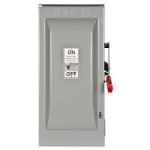Greetings, and thanks for taking the time to read and/or reply!
In installing a UPS, with flex conduit whips to allow the unit to be moved out to 40", we recently failed an inspection.
The 40" whips allow the unit to be pulled out for servicing and any other maintenance.
110.26 reads to work with clearances around electrical panels.
With the UPS "in place" (~13" from the wall), it fails the inspection because the inspector considers the UPS as a panel, as it has breakers (AC input/AC output/DC Batteries) on the rear of the unit.
It is not favored to leave the unit pulled out, as it takes a bit of real estate (and in some locations, could blocks egress out of the room).
We've literally installed thousands, across the US...and this is the first time that we've encountered this interpretation.
Your thoughts/options are appreciated.
Thanks in advance.
In installing a UPS, with flex conduit whips to allow the unit to be moved out to 40", we recently failed an inspection.
The 40" whips allow the unit to be pulled out for servicing and any other maintenance.
110.26 reads to work with clearances around electrical panels.
With the UPS "in place" (~13" from the wall), it fails the inspection because the inspector considers the UPS as a panel, as it has breakers (AC input/AC output/DC Batteries) on the rear of the unit.
It is not favored to leave the unit pulled out, as it takes a bit of real estate (and in some locations, could blocks egress out of the room).
We've literally installed thousands, across the US...and this is the first time that we've encountered this interpretation.
Your thoughts/options are appreciated.
Thanks in advance.




